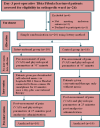Music as an Adjuvant Therapy in Postoperative Pain and Physiologic Parameters: Pre-Test, Post-Test Intervention Study
- PMID: 40568645
- PMCID: PMC12110506
- DOI: 10.4314/rjmhs.v6i3.3
Music as an Adjuvant Therapy in Postoperative Pain and Physiologic Parameters: Pre-Test, Post-Test Intervention Study
Abstract
Background: Poorly controlled postoperative pain remains a significant challenge. Music is a safe, inexpensive, non-invasive intervention that can be used in managing pain in surgical patients.
Objectives: To evaluate effectiveness of music intervention as an adjuvant therapy in attenuating postoperative pain among patients with tibia/fibula fractures.
Methodology: A cross-sectional pre-test, post-test intervention study design was utilized to conduct a study involving 20 tibia-fibula patients, divided equally into intervention and control groups. Self-selected music was administered for 20 minutes to the intervention group once on day-3 after surgery. Data was collected using a demographic questionnaire and Visual Analogue Scale (VAS). Data was analyzed using SPSS software version 29.0. Descriptive statistics analyzed continuous and categorical data. T-test compared means of physiologic parameters and pain levels in pre-and post-intervention. ANCOVA established the relationship between music and post-intervention pain levels.
Findings: Use of music alongside conventional therapy significantly reduced pain in the intervention group than in the control group (P = 0.014). Music had no statistically significant impact on the physiological parameters.
Conclusion: Music therapy is effective as an adjuvant therapy for pain management and can therefore reduce the use of analgesics among surgical patients.
Keywords: Postoperative pain; Tibia/fibula fractures; music; physiologic parameters.
Conflict of interest statement
There are no financial, personal, or professional conflicts of interest that could influence or bias the outcomes, interpretations, or conclusions presented in the manuscript.
Figures
Similar articles
-
Does Augmenting Irradiated Autografts With Free Vascularized Fibula Graft in Patients With Bone Loss From a Malignant Tumor Achieve Union, Function, and Complication Rate Comparably to Patients Without Bone Loss and Augmentation When Reconstructing Intercalary Resections in the Lower Extremity?Clin Orthop Relat Res. 2025 Jun 26;483(9):1680-95. doi: 10.1097/CORR.0000000000003599. Online ahead of print. Clin Orthop Relat Res. 2025. PMID: 40569278
-
Intravenous magnesium sulphate and sotalol for prevention of atrial fibrillation after coronary artery bypass surgery: a systematic review and economic evaluation.Health Technol Assess. 2008 Jun;12(28):iii-iv, ix-95. doi: 10.3310/hta12280. Health Technol Assess. 2008. PMID: 18547499
-
Music interventions for acquired brain injury.Cochrane Database Syst Rev. 2017 Jan 20;1(1):CD006787. doi: 10.1002/14651858.CD006787.pub3. Cochrane Database Syst Rev. 2017. PMID: 28103638 Free PMC article.
-
Cost-effectiveness of using prognostic information to select women with breast cancer for adjuvant systemic therapy.Health Technol Assess. 2006 Sep;10(34):iii-iv, ix-xi, 1-204. doi: 10.3310/hta10340. Health Technol Assess. 2006. PMID: 16959170
-
Sertindole for schizophrenia.Cochrane Database Syst Rev. 2005 Jul 20;2005(3):CD001715. doi: 10.1002/14651858.CD001715.pub2. Cochrane Database Syst Rev. 2005. PMID: 16034864 Free PMC article.
References
LinkOut - more resources
Full Text Sources


